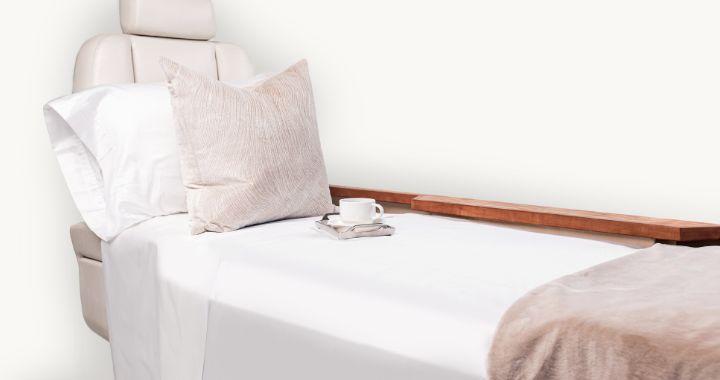Getting quality sleep on an airplane can be one of the biggest challenges for any traveler, no matter how much leg room or privacy your flight offers. Even flying on a private jet doesn’t guarantee a good night’s rest due to ambient noise, changes in cabin pressure, and disruptions from flight attendants.
As most frequent fliers know, arriving at your destination feeling exhausted can really dampen the start of your trip. That’s why doing what you can to catch some sleep while in the air, especially on those long-haul flights, is so important.
With that in mind, we’re sharing these airplane sleeping hacks to help you fall asleep and, importantly, stay asleep while you’re thousands of feet in the sky.
As you fly private, these strategies will make sleeping a breeze. And if you’re lucky to find yourself on one of our Jetbeds, your in-flight sleep experience will be taken to new heights of comfort and relaxation. Join us as we explore these eight airplane sleeping hacks that will revolutionize your in-flight sleep experience!

9 Airplane Sleeping Hacks: Arrive Rested on Your Jetbed
We’ve compiled some of our tried-and-true airplane sleeping hacks that are sure to help you power down and drift off on your next flight. Let’s dive in!
Choose the right seat.
Choosing the right seat can make or break your chances of getting quality rest on a flight. Once you’ve boarded your flight, try to find the seat on the plane that looks most comfortable to you. You can choose a seat where the air won’t be blowing on you or that you are your preferred distance from the restroom.
Additionally, you can try moving to a spot toward the back of the plane for less ambient noise. It can also help to fly through the night on red-eye flights when others are likely to be sleeping.
Bring comfort essentials.
Be sure to pack important comfort essentials to help you sleep comfortably on the plane. In your carry-on, include a travel pillow, eye masks, and noise-canceling headphones to support your neck and block out disruptive lights and noise. Wear baggy, breathable clothes for sleep, too.
It’s also wise to bring any medications you may need if you’ll be sleeping overnight at a high altitude. Some private jets may provide blankets, but it’s better to pack your own lightweight wrapping in case it’s unavailable. You can easily fit it all in a small bag or travel pillow to keep your supplies handy once airborne.
Eat light meals.
What you eat during a flight can affect your ability to sleep. Consuming heavy or spicy meals may cause digestion issues and discomfort, making it harder to relax. It is advisable to stick to lighter menu options that are easier on your system, such as a salad, sandwich, fruit, lean protein, and yogurt. These will fill you up without making you feel overly full or bloated.
It’s also best to avoid sugary snacks too close to bedtime since the energy spike may disrupt your ability to fall asleep. Opting for light, simple meals keeps your stomach settled and mind clear for drifting off, helping you get quality rest on the plane so you arrive refreshed.
Stay hydrated.
Remaining hydrated during flights is important for your overall comfort and your ability to sleep. Consuming plenty of water will compensate for the lower humidity levels and prevent drowsiness caused by dehydration. Avoid alcoholic or caffeinated beverages in the hours before you want to fall asleep, as these are diuretics that can disrupt sleep.
While coffee or wine are tempting, they may necessitate bathroom trips that disturb your rest. Staying hydrated helps prevent fatigue and jet lag, so you feel refreshed when you land.
Manage your body clock.
It’s important to try maintaining your usual sleep schedule during long-haul flights. This helps keep your circadian rhythms regulated despite flying through multiple time zones. However, before take-off, adjust your sleep patterns a few days in advance to the destination time zone. Both tactics allow your body to adapt smoothly and make it easier to fall asleep and wake normally at your destination.

Create a sleep-friendly environment.
Creating the right environment makes falling asleep on a plane much easier. Close the window shade or use a sleep mask to block any bright lighting that can disrupt your sleep. You can also use your noise-canceling headphones to drown out engine hum and other chatting passengers.
You can stow your carry-on securely in the overhead bin so it won’t disturb you. Then, cuddle up with your travel pillow for extra comfort. If you usually carry out nighttime routines, you can also brush your teeth or change into pajamas before bedtime to make your body associate it with rest. These little adjustments can make a huge difference in avoiding disruptions so you can get quality rest on the plane.
Practice relaxation techniques.
Using simple relaxation techniques onboard can help you fall asleep faster in an potentially unfamiliar sleeping environment. Deep breathing and progressive muscle relaxation can effectively calm your busy mind. With deep breathing, inhale slowly for five counts and exhale for seven to quiet your nerves.
For progressive muscle relaxation, tense and release different muscle groups in sequence to relieve physical tension. You can also engage in light stretching exercises before sleeping to improve circulation and reduce stiffness. Relaxation helps reduce stress so you can rest easily despite disruptions.
Find the best sleep position.
Because most airplane seats offer limited space and support, you must find the right sleeping position to get comfortable. However, the same goes if you’re trying to sleep while in a private jet. If there’s space, you can lie on your side with a travel pillow cradling your neck. If you have a window seat, you can also sit upright with your head leaning on the window while using a blanket. You can also curl into the fetal position with your carry-on between your legs for leg support.
However, being able to sleep in any position in your private plane is one of the many reasons you need our comfortable Jetbed and high-quality linens. While basic airplane seats are restrictive, products like the Jetbed allow you to fully lie down flat on your back or side, adopting a natural position so you can maximize your chances of undisturbed shut-eye.
Don’t forget your Jetbed.
For truly undisturbed sleep on a plane, don’t board without your Jetbed. Unlike basic airplane seating that lacks adequate leg room or recline, the Jetbed was specifically designed for comfortable sleep on a plane and allows you to create your ideal micro-environment for total relaxation. As the pioneer of inflatable airplane beds, Jetbed offers several portable, lightweight options perfectly tailored to provide full-body support. It’s also got you covered no matter your airline or seating type, as our various styles adapt to every aircraft configuration.

Rest up and arrive renewed with these tricks up your sleeve.
Whether you implement one or all of the hacks shared here, following these top tips will definitely improve your odds of getting quality rest on any upcoming flights. But for a truly stress-free shut-eye, consider taking your private plane sleeping game to new cruising altitudes with a Jetbed. Kicking back on a Jetbed is the ultimate way to put all stress-induced takeoff anxiety to bed.
If you have any questions about more airplane sleeping solutions or need insider tips about the aviation industry, don’t hesitate to visit our blog. Happy flying and even happier sleeping!

